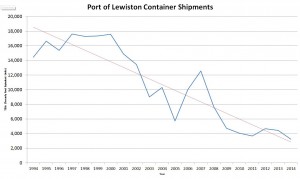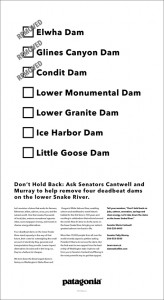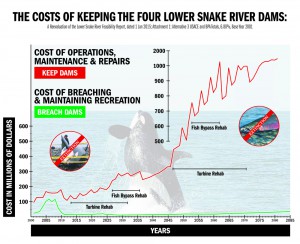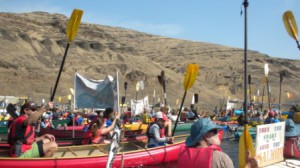The Lewiston Morning Tribune sat down with civil engineer and former Army Corps of Engineers employee Jim Waddell to dig into cost-benefit issues that enshroud the lower Snake River and its cost-heavy dams.
To save orcas, we must save salmon
Posted /UncategorizedThis Seattle Times guest opinion from three of the leading orca researchers in the Pacific Northwest points to a longstanding problem that’s gaining visibility in 2015. Endangered southern Pacific orcas depend heavily on chinook salmon from the Columbia and Snake rivers, and chinook salmon populations have been decimated by dam construction. Not only do the lower Snake River dams waste our taxpayer dollars, but they inflict an extremely high toll on some of our most prized fish and wildlife.
By Ken Balcomb, Martha Kongsgaard, David Troutt
Special to The Times
Our salmon and orcas are at a crossroads. Puget Sound’s resident killer whale population could be headed toward extinction, and saving our region’s salmon — a critical and sharply declining food source for our whales — may be the only way to save these Northwest icons.
A recent Seattle Times article described a possible legal battle over the fate of the southern resident killer whale, Lolita: to keep her in captivity or return her to her native Pacific Northwest waters where her family still live and hunt for salmon.
It should also rekindle a public discussion about our need to improve the health of the environment on which humans, killer whales, and salmon depend. One of the most critical environmental issues we now face in our shared ecosystem is the poor survival of salmon as they travel through the Salish Sea on their way to the Pacific Ocean.
These whales are called “residents” because they spend much of the year in our Salish Sea: the inland marine waters of Washington state and British Columbia that include Puget Sound, straits of Georgia and Juan de Fuca. Like Lolita, our 79 remaining southern resident killer whales are listed as endangered under the federal Endangered Species Act. A limited food supply has been identified as one of the primary reasons for their decline, with big and energy-rich chinook salmon making up more than 80 percent of their preferred diet.
Like the resident whales that depend on them, Puget Sound chinook salmon are also listed as threatened under the Endangered Species Act. The spring chinook run from the mighty Fraser River in southern British Columbia is a fraction of what it once was. We’ve invested thousands of hours of volunteer labor and considerable resources in freshwater and estuary habitat recovery in the region. Harvest rates have been significantly reduced, and hatchery management has undergone major changes. Despite efforts, the abundance of our Salish Sea chinook salmon populations, both wild and hatchery, remains well below what it was 30 years ago.
Why? The survival of both wild and hatchery chinook salmon after they enter the saltwater environment was up to 10 times higher in the early 1980s compared with now. Observed changes in the Salish Sea marine ecosystem are thought to be the cause as no such trend has been observed for salmon leaving and returning to our coastal rivers that empty directly to the Pacific Ocean.
A new international effort, the Salish Sea Marine Survival Project, led by the groups Long Live the Kings and the Pacific Salmon Foundation, is under way to unravel the mystery of why salmon entering Puget Sound and the Strait of Georgia are dying at alarming rates.
This project brings together 150 scientists, 40 organizations including tribal, First Nations and two countries to understand the problems our chinook and other salmon face so that we can take the right actions to protect them.
Early findings of the project show that predation from seals, toxic materials, disease and lack of food may all be contributing to the poor early survival of our salmon and steelhead.
Understanding and addressing these issues would provide hope that Lolita, if she is returned to her native waters, and the rest of the southern resident killer whales have a sustainable future with us in this unique corner of the world we call home.
Ken Balcomb is executive director of Center for Whale Research. Martha Kongsgaard is chairwoman of the Puget Sound Partnership Leadership Council. David Troutt is director of Nisqually Indian Tribe Natural Resources and chair of Puget Sound Salmon Recovery Council.
Click here to read the original guest opinion.
Lewiston Tribune wonders: Will taxpayers dub the Port of Lewiston a Port to Nowhere?
Posted /UncategorizedPort of Lewiston loses 100 percent of its container traffic
Posted /Uncategorized
Commercial shipping on the lower Snake River continues to decline–dramatically.
The Port of Lewiston confirmed yesterday and officially announced today that it was indefinitely suspending container shipments after an international shipper said it would no longer use the Port of Portland on the Columbia River downstream. The Port of Lewiston’s business had constituted the only containerized freight traffic on the lower Snake River.
Container shipments from the Port of Lewiston peaked in 1997 and have been on a dramatic and steady decline ever since. This week’s events underscore how inconsequential lower Snake River shipping has become as port managers scramble for alternatives, including the possibility of shipping via an existing railroad.
The following news article appeared in today’s Lewiston Morning Tribune.
Port container traffic on hold indefinitely
By ELAINE WILLIAMS of the Tribune
The permanent withdrawal of a key overseas shipper from the Port of Portland has put container traffic at Idaho’s only seaport on hold indefinitely for the first time since it started in 1978.
Hapag-Lloyd confirmed Tuesday it’s no longer calling on the Port of Portland and will serve its customers through other locations, such as the Port of Tacoma, according to a prepared statement from the German-based shipper.
“We regret any inconveniences for customers and also any negative impact on the port. Our offices are prepared to offer alternative options.”
Hapag-Lloyd handled the ocean going portion of the journey for more than 90 percent of the containers that originated in Lewiston.
The only remaining container carrier at the Port of Portland is Westwood, and it’s unlikely it will be able to absorb Hapag-Lloyd’s customers from Lewiston since it visits different destinations, said Lewiston Port Manager David Doeringsfeld.
“At this point in time, the Port of Lewiston is not shipping any containers on water,” he said.
Doeringsfeld said he and the port commissioners are trying to grasp what the effect will be and to create a strategy to respond. They will discuss the issue at their meeting today.
The port employs seven people, four at the container yard and three in the administrative office, including one part-time worker.
Doeringsfeld declined to discuss what will become of the employees connected to the container dock.
The container yard was projected to generate about $4,000 in revenue this year after expenses of about $295,000, Doeringsfeld said. In both instances, those figures are roughly half what was originally forecast because the port didn’t predict a slowdown of labor on the West Coast during a contract negotiation where a tentative agreement has been reached, Doeringsfeld said.
Costs would have been more except the port found other jobs for container employees to complete while containers weren’t moving, such as performing maintenance on port-owned buildings.
When the work the employees were doing wasn’t related to the container yard, it was charged to other areas of the budget, Doeringsfeld said.
Those figures come from a $1.9 million budget where gross revenue from the container dock is one of the largest sources of income. The port had expected about $450,000 each from rentals and property taxes as well as $260,000 from Inland 465, a huge warehouse in this fiscal year.
What the port can do for its customers who mostly ship dried peas and lentils is still being determined, Doeringsfeld said.
One possibility is shifting that business to rail, but making the service available is complicated. The Lewiston-Clarkston Valley’s only line, the Great Northwest Railroad, is a short line that would have to negotiate agreements with the carriers it connects with in Washington – Union Pacific or Burlington Northern Santa Fe.
“That’s something that takes months, not weeks,” Doeringsfeld said.
The port also is exploring the possibility of recruiting other business to its container dock, but has no signed contracts at this time, Doeringsfeld said.
That doesn’t necessarily mean the dock will remain inactive, since those agreements are often finalized about 30 days in advance, Doeringsfeld said.
Even though business at the container dock has come to a halt, the port still believes its investment of $2.8 million to more than double the length of its container dock with $1.3 million in federal money was a good choice, Doeringsfeld said. “We will continue to market this asset to promote job creation.”
Losing the container business is a blow, but Doeringsfeld said containers represent only about 15 percent of the tonnage shipped from the Port of Lewiston. The remainder is bulk grain that leaves the Lewis Clark Terminal at the Port of Lewiston.
Overall barge shipping on the Snake and Columbia rivers continues to play an important role in the economy of the Lewiston-Clarkston Valley, Doeringsfeld said.
Clearwater Paper, for instance, barges chips and sawdust for its Lewiston mill to the Port of Wilma just west of Clarkston from Columbia City, downriver of the Portland area.
As the Port of Lewiston determines its next move, many are watching closely, including environmentalists.
Taxpayer subsidies play an increasingly important role at the Port of Lewiston, said Greg Stahl, a spokesman for Idaho Rivers United in Boise, which supports removing the four lower Snake River dams.
“How much economic benefit is this really generating for the amount of outlay?” Stahl said. “In any free-market scenario, it appears the port wouldn’t even exist, at least at this point.”
Patagonia ads take aim at lower Snake dams
Posted /Uncategorized Outdoor clothing company Patagonia took aim squarely at the lower Snake River’s four salmon-killing dams in ads released in Washington state newspapers April 23, 24 and 25.
Outdoor clothing company Patagonia took aim squarely at the lower Snake River’s four salmon-killing dams in ads released in Washington state newspapers April 23, 24 and 25.
The ads, which feature the tagline “Don’t hold back,” show three completed dam removals on the Elwha and White Salmon rivers while also showing that Lower Granite, Little Goose, Lower Monumental and Ice Harbor dams on the lower Snake River are still on the list of wasteful infrastructure that need to go. They ran in in the Spokesman-Review in Spokane, The Olympian in Olympia, The Stranger in Seattle and the Pacific Northwest Inlander in Spokane.
The ads ask Washington state residents to contact Sens. Patty Murray and Maria Cantwell, both Washington Democrats, to ask for lower Snake dam removal. Achieving support from the Washington state senators is an important part of the political puzzle that will ultimately lead to getting rid of the four salmon-killing dams.
Patagonia has a long track record of backing environmental causes. In 2013 the company released the acclaimed documentary DamNation, which puts a spotlight on the nation’s growing trend of dam removals, with a particular focus on the lower Snake River’s wasteful dams. The company organized a letter to the White House and additional elected officials calling for removal of the four wasteful Snake River dams. More than 70,000 signatures were delivered to the White House in January, but if you haven’t yet you still have a chance to sign. Please sign today.
Thanks to Patagonia for putting its money where its mouth is and continuing to raise awareness about government waste on the lower Snake River. And thanks to DamNation’s producers, editors and story tellers who continue to help raise awareness nationwide about the worthwhile work of ending taxpayer waste and restoring our rivers.
Study finds rivers recover very fast when dams are removed
Posted /UncategorizedWhen dams come out, rivers heal and fish return–and it happens very fast.
That’s according to a new study published this week in the journal Science. The study, co-authored by Forest Service Hydrologist Gordon Grant and U.S. Geological Survey Biologist Jeff Duda,was based on the growing number of case studies available. From 2006 to 2014, 548 dams were removed in the United States, nearly double the number removed from 1996 to 2005.
Among their findings, the co-authors made two key points that are extremely pertinent to the discussion about dam removal on the lower Snake River.
- Accumulated sediment dissipates much faster than scientists once estimated.
- Anadromous fish repopulate their native streams very rapidly, sometimes within days.
The following article was published by Oregon Public Broadcasting today, April 30, and can be found here.
Rivers recover rapidly once dams are gone, study finds
By Cassandra Profita
A new study sums up what scientists now know about the environmental effects of removing dams from rivers.
It concludes that rivers and fish respond quickly after a dam is removed, and the results are mostly positive.
“Heraclitus has said you can’t step in the same river twice,”said study co-author Gordon Grant. “Well, you don’t get exactly the same river back after you take a dam off it that you had before, but you can come pretty close. In some cases, it can even be difficult to identify in just a few years where the dam was.”
Rivers often disperse the extra sediment from behind a dam within weeks or months of dam removal, the study finds. Migratory fish move swiftly to recolonize newly accessible habitat – at times swimming past the former dam site within a matter of days.
The research, published Thursday in the journal Science, compiles the findings of more than a hundred studies on individual dam removals.
Grant, a research hydrologist with the U.S. Forest Service, said the number of dams removed has shot up in the past decade. In the U.S. 548 dams were removed from 2006-2014 compared with 298 dams removed from 1996-2005.
That recent round of dam removal has included projects on Washington’s Elwha and White Salmon rivers and Oregon’s Sandy River.
“We wanted to step back from the fray and assess: What have we learned?” he said. “What works, what doesn’t, and what sort of guidance does the past give us in looking towards the future?”
Grant said the effects of dam removal definitely vary depending on the size of the dam, the size of the river, and how much sediment was stored in what size reservoir. But he and his colleagues did find some common lessons.
Before dam removal had been studied, Grant said, scientists thought it might take decades for rivers to disperse the accumulated sediment. But that was not the case in almost all the documented cases. In most cases, it was only a matter of weeks or months.
“Rivers appear very nimble in terms of being able to digest these meals of, in most cases, sediment that has been stored behind these structures, some of which have been in place for close to a hundred years,” he said.
Study co-author Jeff Duda, a biologist with the U.S. Geological Survey, is studying the effects of dam removals on the Elwha River in Washington – the largest dam removal in history.
He said the Elwha has been the biggest test case to date of how a river handles large deposits of sediment released by dam removals. That project started in 2011 and removed the last part of the Elwha Dam last August, releasing 21 million cubic meters of sediment altogether.
“We’ve seen the river downstream handle that input of sediment, and it’s now coming back,” Duda said. “For awhile, it was running pretty muddy, and still does during high flows, but if you go out there during periods of low flow it runs pretty clear again. So, the river is adjusting.”
Duda said scientists are still tracking the long-term effects on fish in the Elwha, but it didn’t take the fish long to reoccupy the habitat above the dams.
“We saw fish here just upstream of Glines Canyon Dam within days of the final blast,” he said. “If you give the fish a chance, if they’re migratory, they will recolonize the streams above dams.”
Overall, Grant said, fish seem pretty well adapted to handling the short-term, large volumes of sediment moving downstream after a dam removal, as it’s similar to what they might see during a flood or volcanic eruption.
“Generally, the fish are reasonably evolutionarily designed to handle disturbances of that kind,” he said. “What we don’t know, though, is whether you get back the sort of fish community you might have had before the dam.”
Researchers found removing a dam can release contaminants stored in sediment, and it’s a good idea to check for that before removing a dam, Grant said.
In a case of “good dam removals gone bad,” he said, the Fort Edward Dam removal on New York’s Hudson River released so much contaminated sediment that the river was later placed on the Superfund list of the nation’s most contaminated sites.
While there have been many positive results documented from dam removals, Grant said, the benefits of dams for water storage and energy – especially in light of climate change – may continue to drive people to build new dams.
“The future of dam removal has to be viewed against this context of a lot of places in the world where dams are still viewed as important steps in development as low-carbon energy sources,” he said. “Our removals in the U.S. are offset in terms of total dams by a lot of new dam construction in South America, Southeast Asia and India.”
Cost analysis shows lower Snake dams will be an ongoing financial sinkhole
Posted /Uncategorized In its 2002 Lower Snake River Juvenile Salmon Migration Feasibility Report, the Walla Walla District of the U.S. Army Corps of Engineers vastly understated the costs of maintaining and operating four dams on the lower Snake River in eastern Washington State. The report concluded that modifications to these dams would result in the recovery of 13 species of threatened and endangered salmon and steelhead, and that the economic benefits of keeping the four Lower Snake River dams in place far exceeded those of a free flowing river.
In its 2002 Lower Snake River Juvenile Salmon Migration Feasibility Report, the Walla Walla District of the U.S. Army Corps of Engineers vastly understated the costs of maintaining and operating four dams on the lower Snake River in eastern Washington State. The report concluded that modifications to these dams would result in the recovery of 13 species of threatened and endangered salmon and steelhead, and that the economic benefits of keeping the four Lower Snake River dams in place far exceeded those of a free flowing river.
An honest economic analysis turns the conclusion of the Lower Snake River Feasibility Report on its head. The belief that we cannot afford to breach the lower Snake River dams is false. The opposite is true. Neither the American public, nor the U.S. Army Corps of Engineers, can afford to keep the four lower Snake River dams in place.
The economic analysis that led to the Walla Walla District’s 2002 decision to keep the dams is seriously flawed. A professional reevaluation of the 2002 report—correcting earlier cost projections with now available actual costs and addressing omissions, errors, miscalculations and faulty assumptions—demonstrates the Walla Walla District understated the true cost of keeping the dams in place by a staggering $140 million on an average annual basis. A reevaluation of the claimed economic benefits of keeping the dams in place will be addressed in a separate report.
Civil Engineer Jim Waddell recently completed the reanalysis presented here. Waddell retired from the U. S. Army Corps of Engineers in 2013 after 35 years with the agency and was the Deputy District Engineer for Programs in the Walla Walla District when the Lower Snake River Feasibility Report was finalized. The Walla Walla District’s faulty analysis and unfounded conclusions in the Lower Snake River Feasibility Report have cost the American public hundreds of millions, and perhaps billions, of dollars in actual expenditures and lost benefits.
- Follow this link to read the report in full: Cost LSR Dams 1-1-2015F-2 vers 7 30 15
- Click here to read a rebuttal to a critique made by the Pacific Northwest Waterways Association: PNWA Wagner Rebuttal 7 29 2015
- Attachment one: Alt 3 Base year 2001 – 6 88 percent COEBPA Sum Cost for Cost Sheet
- Attachment two: Alt 3 Base year 2015 – 6 88 percent COEBPA Sum Cost rev 13mar15
- Attachment three: Alt 3 Base year 200115 – 4 75 percent COEBPA Sum Costs rev 15Mar15
Petitions seek citizen involvement to effect change on the lower Snake River
Posted /Uncategorized Two petitions are circulating this summer that can help bring about change for Northwest salmon, Puget Sound orcas and taxpayers whose dollars are being wasted supporting a broken status quo on the lower Snake River of eastern Washington.
Two petitions are circulating this summer that can help bring about change for Northwest salmon, Puget Sound orcas and taxpayers whose dollars are being wasted supporting a broken status quo on the lower Snake River of eastern Washington.
Though seeking the same outcomes, the petitions ask for different political tactics. The White House petition, which has only been in circulation for a couple of weeks, has generated 390 signatures so far and asks President Obama to issue an executive order to remove the four dams on the lower Snake River.
Please sign the White House petition here.
The other petition, posted to Change.org several months ago, has generated more than 15,000 signatures and seeks Congressional authorization of dam removal on the lower Snake River.
Please sign the Change.org petition here.
“Each year the Snake River dams kill many millions of chinook salmon juveniles as they attempt to navigate the dams and migrate down river and out to the ocean,” according to the Change.org petition. “Despite the dams, some chinook salmon do make it to the ocean and grow to adults. The dams again exact their toll when adult chinook return to the Columbia/Snake watershed to spawn. The dams finish the killing cycle by impeding the chinooks’ return to their spawning grounds.”
Free the Snake Flotilla scheduled for Oct. 3
Posted /Uncategorized On October 3 hundreds of Pacific Northwest residents are gathering to paddle on lower Granite Lake, the reservoir created by Lower Granite Dam, one of four destructive dams on the lower Snake River. All are welcome to join for this historic event.
On October 3 hundreds of Pacific Northwest residents are gathering to paddle on lower Granite Lake, the reservoir created by Lower Granite Dam, one of four destructive dams on the lower Snake River. All are welcome to join for this historic event.
Click here to register and for more details.
The point is to gather as a community to draw attention to the ongoing taxpayer waste and environmental destruction wrought by the four lower Snake River dams. The point is also to come together as a community. Whether advocates for common-sense spending of taxpayer dollars, endangered southern resident killer whales, energy reform, endangered salmon or better transportation alternatives, we have a common cause. which is removal of four wasteful, salmon-killing dams on the lower Snake.
Follow this link for more details and to register. And please join us Oct. 3 to tell our elected leaders it’s time to remove the lower Snake River dams. It’s time to free the Snake.
Starving Orcas and Snake River Dams
Posted /Uncategorizedby Scott Herning
Southern Resident Killer Whale Chinook Salmon Initiative
(This article appeared in the Oct. 14 2015 edition of The Journal of the San Juan Islands)
Recently, a contingent of San Juan Islanders joined three hundred fishermen, Native Americans, farmers, orca activists, business owners and conservationists to advocate breaching four federal dams on the lower Snake River in Southeast Washington. Canoes, kayaks, rafts and drift-boats filled the Snake River near Pullman, Washington. People came from as far away as Alabama to paddle three miles to Lower Granite Dam. There, boaters unfurled a massive floating banner to “Free the Snake”.
The protesters carried signs reading: ‘A River of Negligible Use. Corps of Engineers’ or ‘Something is Happening Here’ Another sign read ‘More Salmon, More Orcas.’
What ‘was’ going on here? How could the Snake River, the largest tributary of the Columbia River, be thought of as ‘insignificant’ by our Government? Together these rivers were once the greatest salmon producers on earth.
How could removing dams save orcas? Easy. The dams have been killing millions of Chinook salmon for nearly 50 years.
Chinook, one of four species of ESA-listed salmon on the Snake, is the preferred prey for the Southern Resident orcas. Starvation is a top threat facing these highly social whales. NOAA’s 2008 Recovery Plan states; “the single greatest change in food availability for Resident orcas since the late 1800s has been the decline of salmon from the Columbia basin.”
The Center for Biological Diversity petitioned NOAA to include these orcas as Endangered; that happened in 2005. A decade later the feds are again being challenged, this time to revise the Southern Resident critical habitat to include coastal waters, which of course, includes the mouth of the mighty Columbia River.
Dam hydropower mistakenly has been thought of as clean energy. That is changing. According to a University of Cincinnati biogeochemist, in 2012 a large Ohio reservoir emitted as much methane, a potent greenhouse gas, as roughly 5800 dairy cows emit over an entire year. Add this to the fact that the lower Snake dams impede access to 5500 miles of cool, climate change resistant salmon spawning and rearing streams, and you have a strong new case that hydropower from dams is indeed ‘dirty energy.’
In the past year, close to 150,000 citizens (through petitions and email campaigns) have supported breaching the four lower Snake River dams to save salmon and orcas. The issue has reached national media attention with articles appearing in National Geographic, Huffington Post, and The New York Times. Leading environmental organizations such as Endangered Species Coalition, Patagonia, Oceana and Whale and Dolphin Conservation are also on board.
Use your superpower. Call our Commander-in-Chief (202-456-1111) and Senators Murray (206-553-5545) and Cantwell (206-220-6400) to tell them we support breaching the four lower Snake River dams to save the Southern Resident orcas. We owe it to the forty-five Southern Resident orcas who were violently captured and sold to marine parks during the construction of these dams. Only one of those Southern Residents remains alive in captivity today, Tokitae, aka Lolita.
Take action at www.srkwcsi.org

